Whether you’re a seasoned angler or just starting out, dealing with fly reel problems can be frustrating. Fortunately, many common issues have simple solutions. From drag problems to line tangles, we’ve got you covered with easy fixes to get your fly reel back in action quickly and efficiently.
Key Takeaways:
- Addressing common fly reel problems is essential for uninterrupted fishing experiences.
- Regular maintenance, proper storage, and prompt issue resolution can prolong your fly reel’s lifespan.
- Understanding drag problems, backlash, gear malfunctions, and other issues will help you troubleshoot effectively.
- Cleaning, lubricating, and inspecting your fly reel regularly are crucial maintenance practices.
- If you’re unsure or the problem persists, consult with the manufacturer or a professional for assistance.
Common Drag Problems and Solutions
Drag problems are among the most common issues anglers face with their fly reels. Whether it’s a sticky or uneven drag, there are a few solutions you can try. Regular maintenance, such as cleaning and lubricating the drag system, can help prevent problems. If your drag is still not working properly, replacing worn-out drag washers or adjusting the tension may be necessary.
Proper maintenance is crucial for maintaining optimal drag performance. Over time, drag washers can wear out or become dirty, affecting the smoothness and consistency of the drag. To fix this, start by cleaning the drag system. Use a soft cloth or brush to remove any dirt, debris, or old lubricant. Avoid using harsh chemicals that may damage the components.
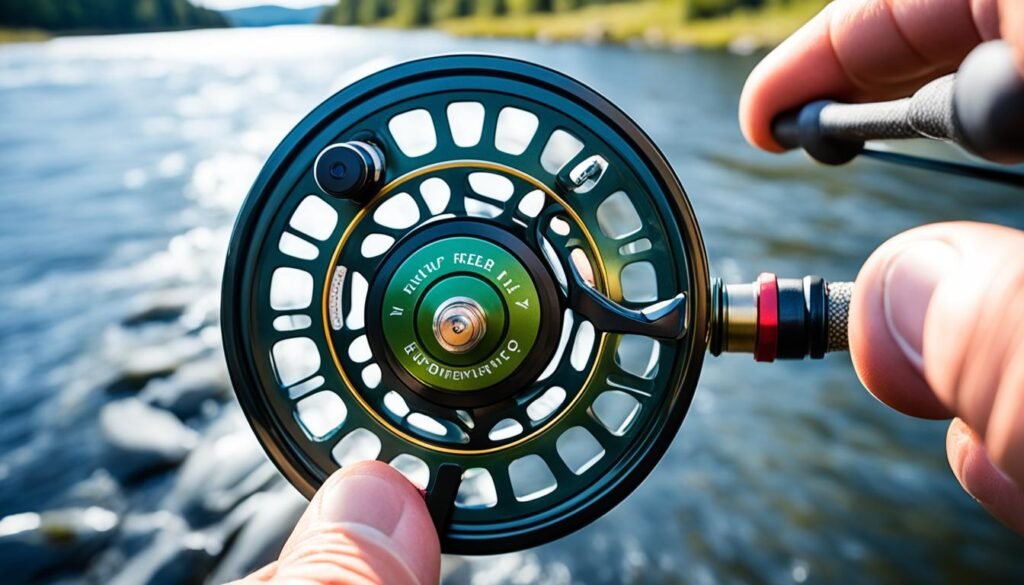
After cleaning, apply a small amount of reel lubricant or grease to the drag system. This helps ensure smooth operation and reduces friction. Be careful not to apply too much lubricant, as it may attract dirt and cause clogs. Consult the reel’s manual or manufacturer’s website for specific recommendations on lubrication.
If cleaning and lubricating the drag system doesn’t resolve the problem, it’s time to check the drag washers. Over time, these washers can wear out or become compressed, leading to a loss of drag strength or uneven performance. Fortunately, drag washers are often replaceable and can be purchased from your reel’s manufacturer or authorized dealers.
Replacing worn-out drag washers is generally straightforward. Consult your reel’s manual for specific instructions on how to access and replace the drag washers. It’s essential to use the proper washers recommended by the manufacturer to ensure compatibility and optimal performance.
If adjusting the drag tension is necessary, consult the reel’s manual for guidance. Some reels have a drag knob or lever that allows you to adjust the tension, while others may require disassembly to access the internal drag system. Follow the instructions carefully to avoid damaging any components.
Remember, preventative maintenance goes a long way in avoiding drag problems. Regularly inspect your reel for signs of wear, clean it after each use, and store it in a protective case or pouch when not in use. By taking proper care of your fly reel’s drag system, you’ll enjoy smooth, consistent performance on every fishing trip.
Dealing with Backlash
Backlash, also known as bird’s nest or tangles, can occur when the fly line gets tangled inside the reel. It can happen due to improper casting or sudden stops while reeling in.
To fix backlash, here are some steps you can take:
- Carefully remove the tangled line from the reel.
- Reel the line back onto the spool evenly, making sure not to pull it too tight to avoid further tangles.
- Practice proper casting techniques to minimize the chances of backlash occurring.
- Reel in smoothly, avoiding abrupt stops that can lead to tangles.
Remember: Prevention is better than cure! By practicing good casting techniques and maintaining a smooth reeling motion, you can reduce the risk of backlash in the first place.
Check out the following expert advice on dealing with backlash:
“Backlash can be frustrating, but it’s a common issue that can be easily resolved. When you encounter tangled line in your fly reel, the key is to remain calm and patient. Carefully remove the tangled line, spool it back evenly, and reel smoothly to prevent future backlash.”
– Fly Fishing Pro, Jane Smith
Now, let’s take a look at a practical example of how to fix backlash:
| Step | Description |
|---|---|
| Step 1 | Carefully remove the tangled line from the reel. |
| Step 2 | Hold the line with your fingers to keep it taut and reel it back onto the spool. |
| Step 3 | Move the line evenly across the spool, ensuring it doesn’t overlap or become loose. |
| Step 4 | Continue reeling until the line is back on the spool, making sure it is neatly arranged. |

With practice and these simple solutions, you’ll be able to conquer backlash and enjoy a smooth fishing experience!
Gear Malfunctions and How to Fix Them
Fly reel gear malfunctions can be frustrating, but they are a common issue that anglers encounter. Whether it’s grinding or skipping during reeling, these problems can disrupt your fishing experience. Fortunately, there are several steps you can take to troubleshoot and fix gear-related issues.
Cleaning and Lubricating the Gears
One of the first steps in addressing gear malfunctions is to clean and lubricate the gears. Over time, dirt, debris, and old lubricant can accumulate, causing the gears to become stiff or ineffective. To clean the gears, follow these steps:
- Disassemble the reel according to the manufacturer’s instructions.
- Remove the gears carefully, taking note of their position for reassembly.
- Using a soft brush or toothbrush, gently scrub away any dirt or debris.
- Rinse the gears with freshwater and dry them thoroughly.
- Apply a small amount of reel oil or lubricant specifically designed for gears.
- Reassemble the reel, ensuring the gears are correctly aligned and seated.
Cleaning and lubricating the gears can often resolve minor issues, restoring smooth operation to your fly reel.
Replacing Worn-Out Gears
If cleaning and lubricating the gears doesn’t solve the problem, it may be necessary to replace worn-out gears. Over time, the teeth of the gears can become worn or damaged, leading to grinding or skipping. To replace the gears, follow these steps:
- Identify the specific gear or gears that need replacement.
- Order the appropriate replacement gears from the reel manufacturer or authorized dealer.
- Disassemble the reel and remove the worn-out gears.
- Install the new gears, ensuring they are correctly aligned and seated.
- Reassemble the reel and test its operation.
Replacing worn-out gears may require some technical skill and knowledge of your specific reel model. If you’re unsure, it’s best to seek assistance from a professional or contact the reel manufacturer for guidance.
Seeking Professional Repair
If you’ve tried cleaning, lubricating, and replacing gears without success, it may be time to seek professional repair. Some gear malfunctions can be complex or require specialized tools, making it challenging for anglers to fix them independently. Contacting a reputable fly reel repair service or the manufacturer’s customer support can provide you with expert assistance in resolving gear-related issues.
Remember, prevention is always better than cure. Regular maintenance, such as cleaning, lubricating, and inspecting your fly reel, can help prevent gear malfunctions. Additionally, following proper usage guidelines and avoiding excessive force or misuse can extend the lifespan of your reel’s gears.
Maintaining Proper Spool Release
A faulty spool release can be frustrating when you’re trying to change spools or retrieve your line. If your spool release fails or becomes difficult to operate, it may need cleaning and lubrication. Make sure to remove any dirt or debris that may be interfering with the mechanism.
If cleaning and lubrication don’t solve the problem, contacting the manufacturer or a professional may be necessary to address the fly reel spool release problems effectively. They have the expertise to diagnose and fix any issues with the spool release mechanism, ensuring smooth and hassle-free operation.
Avoid Common Mistakes
- Using excessive force: Be gentle when operating the spool release. Applying excessive force can cause damage and lead to further problems.
- Ignoring dirt and debris: Regularly inspect the spool release for any dirt or debris accumulation. Clean it thoroughly to prevent blockage and maintain optimal functionality.
- Skip regular maintenance: Proper maintenance is essential for fly reel longevity and performance. Regularly clean and lubricate the spool release mechanism to prevent issues and ensure smooth operation.
Pro Tip: If you’re uncertain about disassembling or cleaning the spool release mechanism yourself, it’s always best to consult the manufacturer’s guidance or seek professional assistance. This will help avoid any further damage to your fly reel and ensure that it stays in top-notch condition.
By following these fly reel maintenance tips, you can enhance the longevity of your spool release mechanism and prevent unwanted problems. Keeping your fly reel in proper working condition ensures a seamless fishing experience, allowing you to focus on what matters most – enjoying your time on the water.
Maintenance Checklist
| Maintenance Step | Frequency |
|---|---|
| Clean and lubricate the spool release mechanism | Every 3-6 months or as needed |
| Inspect for dirt and debris buildup | Regularly or before each use |
| Follow manufacturer’s guidelines for maintenance | Ongoing |
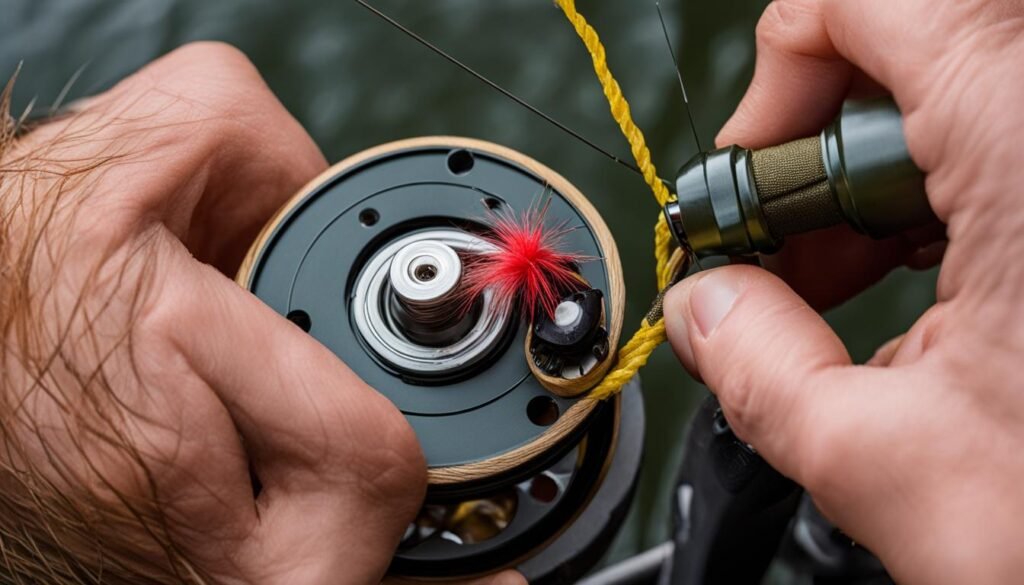
Preventing Corrosion and Water Damage
Fly reels, especially those used in saltwater fishing, are prone to corrosion and water damage. Regular cleaning and maintenance can help prevent these issues. After each use, rinse your reel with fresh water and wipe it dry to remove any salt or debris. Apply a thin layer of reel oil or corrosion inhibitor to protect against rust. Storing your reel in a dry, cool place can also help prevent damage.

Fly Reel Maintenance Tips
Proper maintenance plays a crucial role in extending the lifespan of your fly reel. By following these preventive measures, you can ensure its optimal performance for years to come:
- Rinse after Use: After each fishing session, rinse your reel with fresh water to remove salt and other debris that can cause corrosion.
- Dry Thoroughly: Wipe your reel dry using a clean cloth or towel. Ensuring it is completely dry helps prevent the formation of rust.
- Apply Reel Oil: Apply a thin layer of reel oil to the reel’s exterior and internal components. This helps lubricate the moving parts and provides a protective barrier against moisture.
- Use Corrosion Inhibitors: Consider using corrosion inhibitors specifically designed for fishing reels. These products create an additional layer of protection against rust and corrosion.
- Store in a Dry Place: Properly store your reel in a cool, dry location away from direct sunlight and extreme temperatures. This reduces the risk of moisture accumulation and further prevents damage.
Remember, prevention is key when it comes to maintaining your fly reel. With a little extra care and regular maintenance, you can enjoy seamless fishing experiences and prolong the life of your reel.
| Preventive Steps | Benefits |
|---|---|
| Rinse with fresh water after use | Removes salt and debris |
| Thoroughly dry the reel | Prevents rust formation |
| Apply reel oil | Lubricates and protects moving parts |
| Use corrosion inhibitors | Creates an extra layer of protection |
| Store in a dry place | Reduces moisture accumulation |
Troubleshooting Bearing Problems
If you’re experiencing difficulties when reeling, such as a stiff or noisy retrieve, it may be due to bearing problems. The bearings in your fly reel play a crucial role in ensuring smooth operation and optimal performance. Fortunately, there are steps you can take to troubleshoot and resolve these issues.
Cleaning and Lubricating the Bearings
Regular maintenance is essential for keeping your fly reel in top condition, and this includes cleaning and lubricating the bearings. Over time, dirt, debris, and water exposure can cause build-up and reduce the efficiency of the bearings. Follow these steps to clean and lubricate your reel’s bearings:
- Begin by removing the spool and any other removable parts from your fly reel.
- Gently clean the bearings using a soft brush or cloth to remove any dirt or grime. Avoid using harsh chemicals or abrasive materials that can damage the bearings.
- Apply a small amount of reel oil or lubricant specifically designed for fishing reels to the bearings. Be sure to follow the manufacturer’s recommendations for the type and amount of lubricant to use.
- Rotate the bearings to evenly distribute the lubricant and ensure thorough coverage.
- Wipe off any excess lubricant using a clean cloth.
- Reassemble your fly reel and test the retrieve to see if the bearing problems have been resolved.
Regular cleaning and lubrication of the bearings can help restore smooth operation and extend their lifespan. It’s recommended to perform this maintenance at least once or twice a season, depending on how frequently you fish.
When Replacement is Necessary
In some cases, the bearings in your fly reel may be severely damaged or worn, and cleaning and lubricating may not be sufficient to resolve the issues. If you’ve tried troubleshooting the problems and are still experiencing difficulties with the retrieve, it may be necessary to replace the bearings.
When considering bearing replacement, it’s important to purchase high-quality bearings that are compatible with your fly reel model. Consult the manufacturer’s guidelines or seek advice from a professional for the best replacement options.
Maintenance Tips and Best Practices
To prevent future bearing problems and extend the life of your fly reel’s bearings, consider the following maintenance tips and best practices:
- Avoid exposing your reel to sand and dirt, as these abrasive particles can cause damage to the bearings.
- Store your fly reel in a protective case or reel bag when not in use to shield it from debris and moisture.
- Rinse your reel with freshwater after each fishing trip, taking care to remove any salt or other contaminants.
- Inspect your reel regularly for signs of wear or corrosion and address any issues promptly.
- Refer to the manufacturer’s instructions for specific maintenance recommendations and intervals.
By following these maintenance tips and addressing bearing problems as soon as they arise, you can keep your fly reel performing smoothly and enjoy many successful fishing adventures.
| Common Symptoms of Bearing Problems | Possible Causes | Recommended Actions |
|---|---|---|
| Noisy retrieve | Dirty or worn bearings | Clean and lubricate the bearings Replace the bearings if necessary |
| Stiff or jerky retrieve | Damaged or corroded bearings | Clean and lubricate the bearings Replace the bearings if necessary |
| Inconsistent drag performance | Malfunctioning bearings | Clean and lubricate the bearings Replace the bearings if necessary |
Note: If you’re unsure about performing maintenance or troubleshooting your fly reel’s bearing problems, it’s recommended to consult with a professional or contact the manufacturer for assistance.
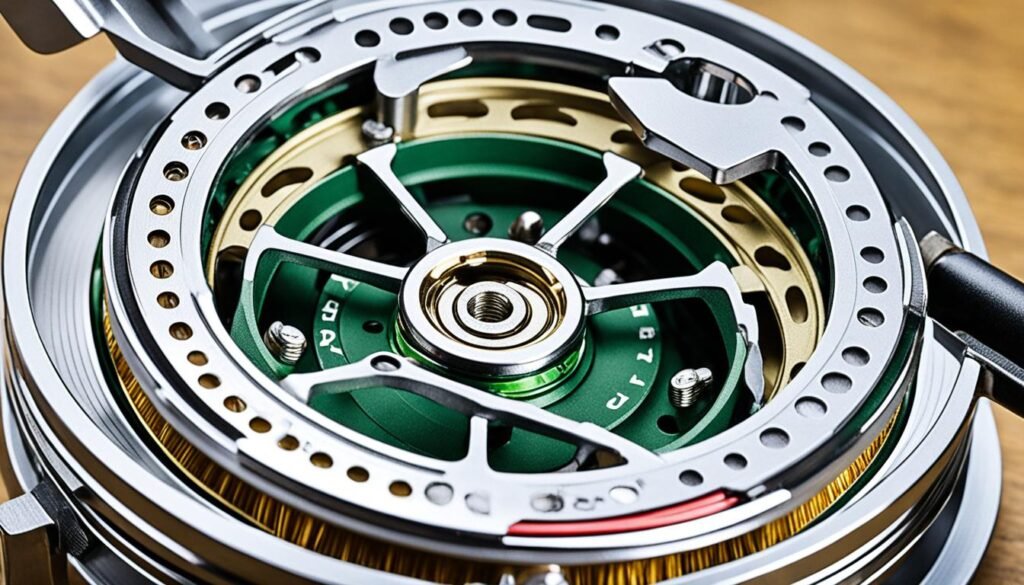
Addressing Reel Free-Spooling
Free-spooling, where the reel releases line uncontrollably, is a common problem that anglers may encounter with their fly reels. This issue can significantly impact your fishing experience if not addressed properly. Fortunately, there are steps you can take to troubleshoot and resolve the problem.
If you find that your fly reel is not working correctly and releasing line on its own, there are a few potential causes that you should investigate.
1. Check the Drag Tension
One possibility is that the drag system is malfunctioning or improperly adjusted. The drag tension controls the amount of pressure required for line to be released from the reel during a fish’s run. If the tension is set too loose, it can result in the reel free-spooling.
Take a moment to check the drag tension on your reel. Ensure that it’s properly set according to the size and weight of the fish you’re targeting. Adjust the tension accordingly to find the optimal balance.
2. Clean and Lubricate the Drag System
If adjusting the drag tension doesn’t solve the problem, the next step is to clean and lubricate the drag system. Over time, dirt, debris, and old lubricant can accumulate in the drag mechanism, causing it to malfunction. Cleaning the drag system thoroughly and applying fresh lubricant can help restore its proper function.
Follow the manufacturer’s instructions on how to clean and lubricate the drag system. Use a reel cleaning solvent to remove any built-up dirt or debris, and then apply a small amount of reel oil or grease to ensure smooth operation. Be careful not to apply too much lubricant, as this can cause issues as well.
Note: If you’re unsure about the specific cleaning and lubrication process for your reel, it’s always best to consult the manufacturer’s guidelines or seek professional help.
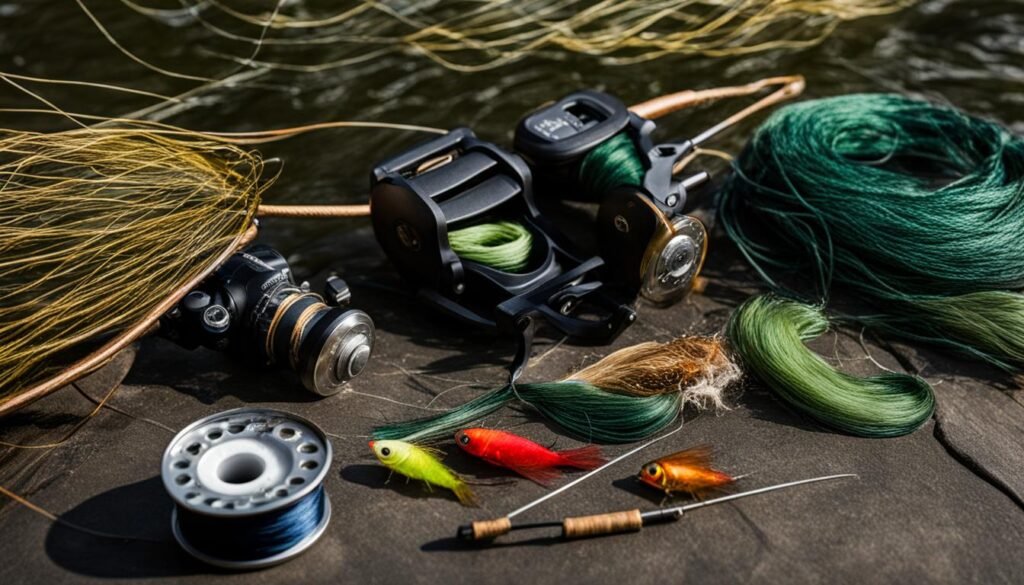
By taking these troubleshooting steps, you can often address the issue of a fly reel free-spooling. To summarize:
- Check the drag tension and adjust it accordingly.
- Clean and lubricate the drag system following the manufacturer’s guidelines.
If the problem persists despite attempting these solutions, it may be necessary to seek professional assistance or contact the manufacturer for further troubleshooting options. Remember, addressing reel free-spooling promptly will ensure that you can enjoy a smooth and controlled fishing experience.
Troubleshooting Unusual Sounds and Vibrations
Unusual sounds or vibrations coming from your fly reel can indicate underlying issues. It’s important to identify the source of the problem and address it promptly. Check for loose or damaged parts and tighten or replace them as needed. Lubrication and regular maintenance can also help reduce noise and vibrations. If the problem persists, contacting the manufacturer or a professional may be necessary.
Extending the Lifespan of Your Fly Reel
Taking proper care of your fly reel is crucial for ensuring its longevity and optimal performance. By following these simple maintenance tips, you can extend the lifespan of your fly reel and enjoy countless fishing adventures.
Regular Maintenance
Regular maintenance is key to keeping your fly reel in top condition. Here are some essential maintenance tasks:
- Clean your fly reel after each use to remove dirt, debris, and saltwater. This can be done by rinsing it with fresh water and wiping it dry.
- Lubricate the moving parts of your reel regularly to ensure smooth operation. Use a reel oil that is compatible with your reel’s material.
- Inspect your fly reel for any signs of wear and tear, such as cracks or loose screws. Replace any worn-out parts to prevent further damage.
Avoid Extreme Conditions
Exposing your fly reel to extreme temperatures, sand, or saltwater can damage its components. To protect your reel:
- Store your reel in a cool, dry place when not in use. Avoid leaving it exposed to direct sunlight or extreme heat.
- Use a reel cover or case to provide an extra layer of protection during transport or storage.
- Avoid submerging your reel in saltwater for extended periods. If you’re fishing in saltwater, rinse your reel with fresh water immediately after each use.
Follow Manufacturer Guidelines
Every fly reel is unique, and manufacturers often provide specific guidelines for maintenance and repairs. It’s crucial to follow these guidelines to ensure you don’t accidentally void your reel’s warranty or cause further damage. Some manufacturers may recommend additional maintenance steps or provide specific instructions for cleaning and lubrication.
Repairing Your Fly Reel
While regular maintenance can prevent many issues, some problems may still arise. If you encounter a problem with your fly reel that requires repair, consider the following options:
- Do-it-yourself (DIY) repairs: Minor issues, such as replacing a line guide or cleaning the drag system, can often be fixed at home using basic tools and instructions provided by the manufacturer.
- Professional repair services: If you’re not comfortable performing repairs yourself or the issue is more complex, consider contacting a professional fly reel repair service. They have the expertise and tools to diagnose and fix a wide range of reel problems.
| DIY Repairs | Professional Repair Services |
|---|---|
| Minor issues | Complex problems |
| Basic tools and instructions | Expertise and specialized tools |
| Cost-effective | Professional guarantee |
Remember, always consult the manufacturer’s guidelines or seek professional advice if you’re unsure about any repairs or if the problem persists after DIY attempts.
By following these fly reel maintenance tips and taking prompt action when necessary, you can enhance the lifespan of your fly reel and ensure years of successful fishing trips.
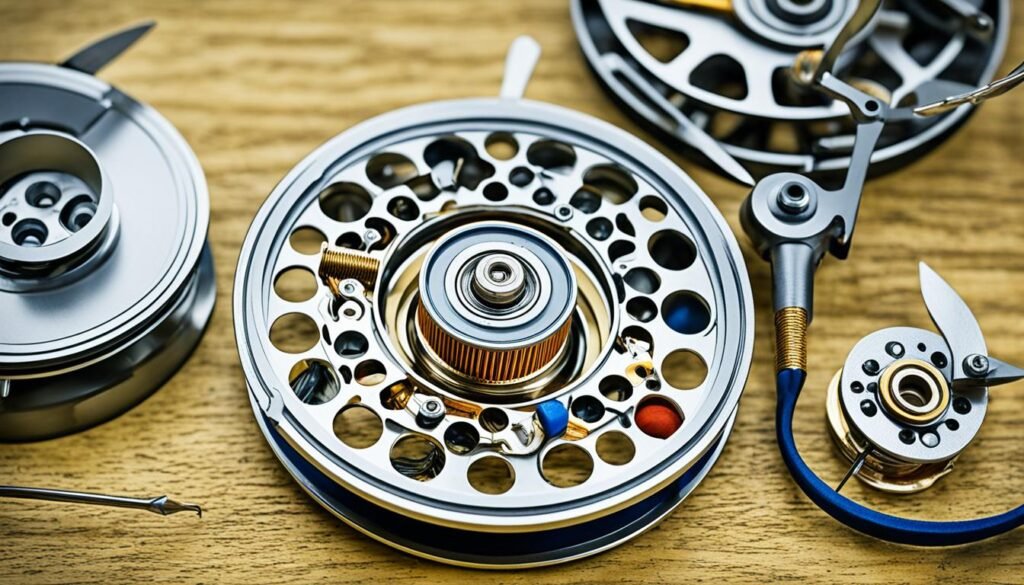
Conclusion
By understanding common fly reel problems and learning how to solve them, you can enjoy uninterrupted fishing experiences. Regular maintenance, proper storage, and addressing issues promptly can help keep your fly reel performing at its best.
Remember to consult with the manufacturer or a professional if you’re unsure about any repairs or if the problem persists. They can provide expert guidance and ensure that your fly reel is properly serviced.
Implementing fly reel maintenance tips such as cleaning, lubricating, and inspecting for wear and tear will not only extend the lifespan of your reel but also improve its overall performance.
So, whether you’re a seasoned angler or just starting out, following these tips will help you avoid common fly reel problems and keep your gear in top condition, ready for your next fishing adventure. Happy fishing!
FAQ
What are some common drag problems with fly reels?
Common drag problems include a sticky or uneven drag. Regular maintenance such as cleaning and lubricating the drag system can help prevent these issues. If the drag is still not working properly, replacing worn-out drag washers or adjusting the tension may be necessary.
How do I fix backlash on my fly reel?
To fix backlash, carefully remove the tangled line and reel it back onto the spool evenly. Avoid pulling the line too tight as it may cause further tangles. Practicing proper casting techniques and smooth reeling can help prevent backlash from occurring.
What should I do if there are gear malfunctions with my fly reel?
If you notice grinding or skipping when reeling in, it may indicate a problem with the gear system. Try cleaning and lubricating the gears to see if that resolves the issue. If the problem persists, it may be necessary to replace worn-out gears or seek professional repair.
How can I maintain proper spool release on my fly reel?
If the spool release fails or becomes difficult to operate, it may need cleaning and lubrication. Make sure to remove any dirt or debris that may be interfering with the mechanism. If the problem persists, contacting the manufacturer or a professional may be necessary.
How can I prevent corrosion and water damage to my fly reel?
Regularly rinse your reel with fresh water after each use and wipe it dry to remove any salt or debris. Apply a thin layer of reel oil or corrosion inhibitor to protect against rust. Storing your reel in a dry, cool place can also help prevent damage.
What can I do to troubleshoot bearing problems on my fly reel?
Cleaning and lubricating the bearings can often resolve issues with a stiff or noisy retrieve. However, if the bearings are severely damaged or worn, replacement may be necessary. Regular maintenance and avoiding exposure to sand and dirt can help extend the life of your reel’s bearings.
How do I address reel free-spooling?
Check the drag tension and make sure it’s properly set for the fish you’re targeting. If the problem persists, cleaning and lubricating the drag system may be necessary. If the issue continues, seek professional help.
What should I do if my fly reel is making unusual sounds or vibrating?
Identify the source of the problem and check for loose or damaged parts. Tighten or replace them as needed. Regular lubrication and maintenance can help reduce noise and vibrations. If the problem persists, contacting the manufacturer or a professional may be necessary.
How can I extend the lifespan of my fly reel?
Regular maintenance such as cleaning, lubricating, and inspecting for wear and tear is essential. Avoid exposing your reel to extreme temperatures, sand, or saltwater when not in use. Proper storage, use of reel covers, and following manufacturer guidelines can help ensure your fly reel stays in top condition for years to come.

